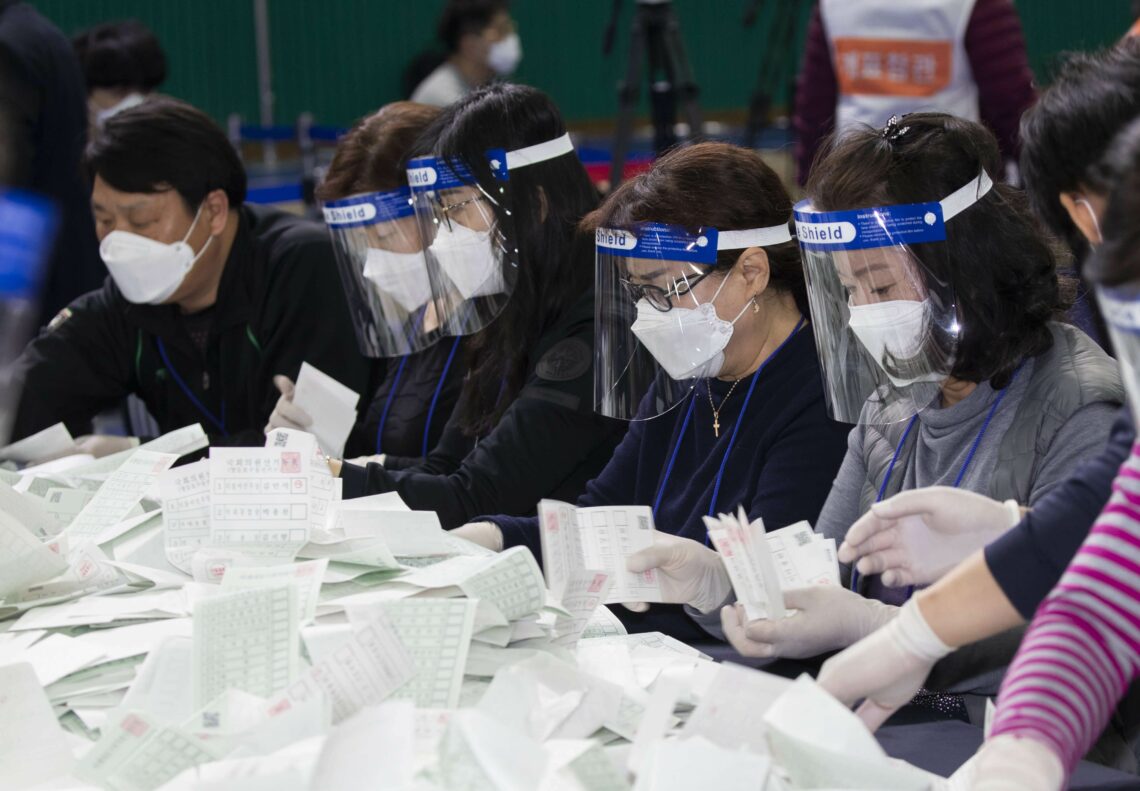South Korea points the way
Sociocultural factors can explain the model reaction of South Korea to the Covid-19 pandemic. The country’s postwar years led to a strong sense of civic duty. However, this success on the health front does not preclude economic difficulties amid the global recession.

In a nutshell
- South Korea’s handling of the pandemic can serve as a model
- Civil obedience and the government’s efficiency proved crucial
- Regional integration will help the economy recover
The Covid-19 crisis has provided rare insights into the hidden strengths and weaknesses countries had accumulated long before the pandemic struck. A telling example is South Korea, whose fight against the coronavirus was a resounding success. Seoul was remarkably alert in tackling this new public health threat. After an initial spike of infection, authorities quickly reacted and implemented a rigorous program of mass testing and social isolation. The number of daily cases peaked in late February and rose for only a little over two weeks, after which the number of new cases was contained. So far, the number of deaths remains below 300.
This favorable outcome cannot be understood without looking into the history and culture of the Korean people.
The Republic of Korea, commonly known as South Korea, is home to some 52 million people – twice the size of the population of its communist neighbor, North Korea. Gross domestic product (GDP) calculated on the basis of purchasing power parity (PPP) amounts to some $2.3 trillion, 12th in the global ranking. Per capita GDP (on the same basis) is $47,000 – roughly the same as that of the United Kingdom.
South Korea had to revive its political system under the constant threat of war.
In the early 1950s, the Korean Peninsula saw one of the bloodiest wars in recent history, leaving both North and South Korea in ruin and misery. Until today, a stable peace eludes the region. After the acquisition of nuclear weapons by North Korea, some consider the region a dangerous powder keg. South Korea had to revive its economy and political system under the constant threat of war.
Modernization
Two of the critical elements in South Korea’s success in fighting Covid-19 have been the efficiency of the government and the discipline of the citizens. These traits have not emerged overnight but are part of a tradition that goes back to the aftermath of the Korean War. Like neighboring Japan, South Korea has no natural resources to speak of, neither fossil fuels nor minerals. Its only asset is the skill of its people.
After the war, the country did not linger in self-pity. Instead, it mustered its collective will to come out of underdevelopment and poverty rapidly. Soon enough, the country came to be known as one of the “Four Asian Tigers.” In 1996, South Korea joined the Organisation for Economic Co-operation and Development (OECD), the first developing country to become a member.
On a much larger scale, China has followed the path of economic modernization pursued by South Korea and Japan. While this is an achievement of genuinely monumental dimensions, in political terms, the People’s Republic of China has blocked all sensible institutional reforms and remains locked in outdated totalitarianism.
South Korea has no natural resources to speak of, neither fossil fuels nor minerals. Its only asset is the skill of its people.
Meanwhile, South Korea has undergone a substantial political change. For some 30 years after its establishment, the country remained subject to military authoritarianism. In 1992, procedural democracy was established and the country built a functioning democratic state based on the rule of law. Today, along with Taiwan, South Korea is one of the most vibrant liberal democracies in East Asia.
Seoul is proof that economic development and political emancipation can go hand in hand and must not be played off against the other. Today the country has an unbroken tradition of democratic succession. It even managed to hold national parliamentary elections amid the pandemic in April 2020. In the highest turnout in 30 years, more than 29 million people went to the polls, with no significant complaints about irregularities.
Remarkably, in the process of its economic modernization, the country has created some of the best-known brand names in the world. Recently, leading South Korean enterprises have even become models for Japanese companies. In the fields where soft power counts, such as entertainment, South Korea has left Japan behind. In 2020, a South Korean movie won the Oscar for best picture.

Confucianism
To draw lessons from how South Korea successfully handled the Covid-19 outbreak, one also has to take a comprehensive look at socioeconomic and cultural factors. While South Korea is a democracy with a functioning constitutional state, its society is rooted in Confucianism. Unlike in the contemporary West, the emphasis is not on rights and claims but on duties and obligations in the Confucian world order.
South Koreans have an ingrained respect for their obligations toward the state.
As a result of this Confucian influence, South Korean citizens have an ingrained respect for their obligations toward the state and obedience to the authorities. But Confucianism also focuses on the obligations that a ruler has toward his or her subjects. There has to be law and order, borders have to be safe and the people must prosper. If a ruler fails to provide these circumstances, subjects are entitled to topple him or her.
In this world of mutual obligations, it was therefore logical that the South Korean authorities would react fast and with great determination. The citizens, meanwhile, took the new rules in stride and meticulously adhered to them.
Scenarios
South Korea has to function in a stressful environment, especially with the permanent threat that emanates from the unpredictable regime in Pyongyang. Recently, the geopolitical environment in East Asia has also been affected by the erratic foreign policy of the United States. While no signs indicate an imminent outbreak of hostilities, the situation has become more volatile and is likely to remain so in the years to come.
East Asia, unlike Europe, does not have a regional security architecture. South Korea and Japan are bilateral allies of the U.S. The personal engagement U.S. President Donald Trump has shown in his relations with North Korean leader Kim Jong-un has unsettled Seoul. Most notably, South Korean President Moon Jae-in has been left on the sidelines. It is rather disturbing to see Washington accept the launchings of North Korean missiles, in clear violation of international norms, without any criticism from President Trump.
More recently, the unexplained temporary absence of North Korean leader Kim Jong-un, which culminated in speculations about his demise, has demonstrated how little the world knows about what is going on in the Hermit Kingdom. Most alarming are prospects of vast turmoil should Mr. Kim die suddenly. Beijing is enhancing its hegemonic ambitions by being the sole arbiter of the North Korean situation. With an assertive China on the military front, future security scenarios for South Korea have to take into account Beijing’s strategic intentions. In parallel, the U.S. appears to be disengaging from the international scene and cannot be counted on as an unconditional military ally.
While the modernization and massive expansion of South Korea’s economy were primarily due to the hard work and discipline of its citizens, globalization contributed, like in the highly industrialized countries in the West. South Korea has managed to successfully penetrate the most difficult Western markets with a wide range of goods, including automobiles, ships, household supplies and electronic devices. South Korean goods proved to be competitive in terms of quality, reliability and price.
South Korea will not be able to buck the trend on its own.
The growth of the past decades also results from the extensive use of global supply chains. In many ways, South Korea was more successful than most other industrialized nations. In the age of “global sourcing” and “just-in-time (JIT) delivery,” competent supply chain management opened the door to the global economy. But institutional weaknesses would eventually surface. The Covid-19 crisis brought these deficiencies to light by demonstrating the vulnerability of global supply chains. In the case of South Korea, this became evident as soon as suppliers and producers from China could no longer function.
Assuming that Covid-19 has changed the nature of the global economy, South Korea will have to adjust to a world where major economic players have rediscovered the attractions of self-reliance. Those who were not blinded by Chinese propaganda were always aware that the Chinese economic miracle was based on a good dose of mercantilism. In the years to come, this course will become more widespread. In the fight against the coronavirus, every government in Asia has stressed the need to enhance self-reliance. In practice, that means more than simple stockpiling of goods. It also requires keeping foreign predators from acquiring vital industries, and using government support and trade restrictions to shore up the domestic industry, particularly small and medium enterprises.
South Korea will not be able to buck the trend on its own. Therefore, it will most certainly gear its foreign trade policy to revive and enhance regional integration in East and Southeast Asia. Looking even further, Seoul will strengthen trade links with India, where its major conglomerates like LG, Hyundai and Lotte already have a solid presence.
Beijing, too, will need to give more attention to the immediate neighborhood. For South Korea any scenario bringing back the economy to its old strength will include the platform of ASEAN+3 (comprising the members of the Association of Souteastern Asian Nations, China, Japan and South Korea).
Despite American objections, South Korea has joined the Asian Infrastructure Investment Bank (AIIB). With the Asian Development Bank (ADB), the WTO and regional free trade organizations Seoul will contribute to regional trade and investment flows. In the case of the AIIB, South Korea will use its membership primarily to get access to major Asian infrastructure projects funded by the bank.








